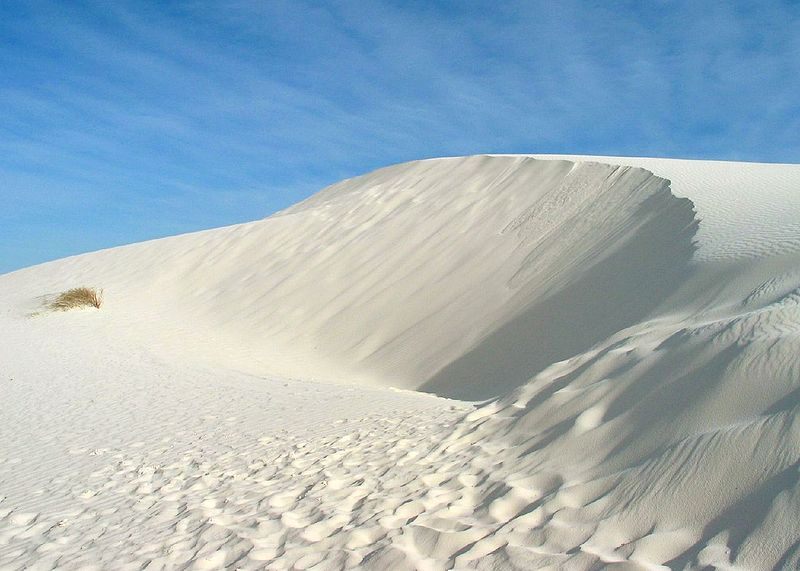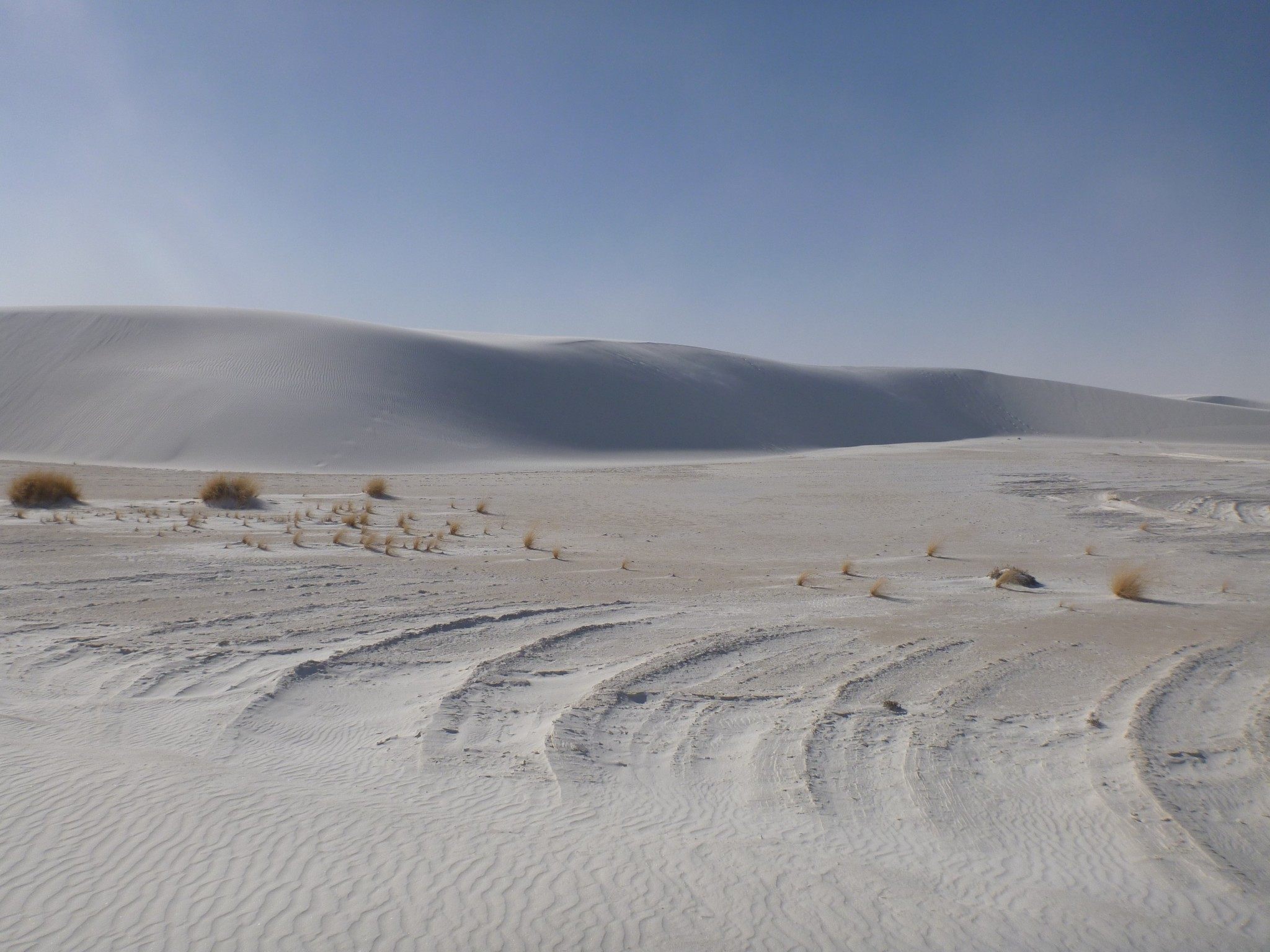The Secret Lives of Sand Dunes
They’re not actually alive, of course, but they do migrate.

Chances are good that no matter where you look while visiting White Sands National Monument, in New Mexico’s Tularosa Basin, you’ll see powdery gypsum dunes. In front of you, behind you, on all sides, you’ll find white humps, maybe two or three times taller than you are. The dune fields go on for some 275 square miles in all (including 160 square miles that aren’t publicly accessible), and it’s easy to imagine them reaching to the horizon, stretching far into the future and back into the past.
Dunes may look monumental, but their grains don’t stay in one place for long. “It’s a constantly shifting environment,” says Raleigh Martin, an AAAS Science & Technology Policy Fellow at the U.S. National Science Foundation who worked on research at White Sands during his graduate work in Earth and environmental studies at the University of Pennsylvania. The dune field at White Sands began to form several thousand years ago, at the end of the last Ice Age, when an ancient lake evaporated and left behind a dry lake bed caked with selenite, a type of gypsum. These broke down into small grains, which the wind gathered into dunes. Like dunes elsewhere, these mounds are still continuously sculpted and remade by the wind.
White Sands’ sprawling field is home to several types of dunes. At the most upwind edge, you’ll find transverse dunes, which can stretch hundreds of feet wide. A mile or so downwind from those, you’ll find barchan dunes—with sloping arms forming the shape of a crescent moon—and two or three miles downwind from the barchans, there are lower, rounder, lumpier parabolic dunes, whose arms face upwind and may be speckled with plants. On barchan dunes, grains from the upwind side, or stoss, crest and tumble down the slip-face side, which is known as the lee. These avalanches happen at an angle of roughly 35 degrees. Over the course of a day, wind whisks some grains across a dune field, ferrying them from one heap to another. On a larger time scale—months, years, decades, millennia—the entire dune field migrates, crawling along the desert itself. “It’s like a conveyer belt action,” says Martin.

The movement of dunes also seems to be related to seasons and daily cycles. Along with several collaborators, including Martin, Douglas Jerolmack—a geophysicist at the University of Pennsylvania who has studied sediment transport at White Sands—found that the movement of dunes is correlated with a large temperature difference between day and night. That gulf creates an instability between the heat of the ground and lower atmosphere and the cooler air above, which then begins to convect and stirs the sand.
That means that spring is a busy time for dunes. Say it’s an April morning—calm, clear, and a little cool. Clouds might tumble by high above you, but on the ground, there’s no breeze tousling the grains. The dunes are steady and still. “Dunes go to sleep at night, and wake up the next afternoon,” says Jerolmack. As the day wears on and the sun bakes the sand, the little grains start moving. “Around about noon, you start to see little dust devils kicking off in the distance,” Jerolmack says, “indicating that there’s a little wind picking up somewhere.”

In the springtime, when the daytime temperature is around 80 degrees Fahrenheit and the nighttime temperature approaches freezing, Jerolmack adds, an afternoon wind might be expected to blow around five meters (or 16 feet) per second, and propel grains along like a “fine, fuzzy film” bouncing about four inches off the ground. To someone trekking across the park, that’s nothing too uncomfortable. “Imagine you’re on a beach on a windy day,” Jerolmack says. “If you’re picnicking, you get annoyed, but if you stand up, you’re fine.” But things can get frustrating—or even dangerous—pretty quickly. If the wind gusts at eight or nine meters (26 or 29 feet) per second, grains may be carried high enough to rap you on the face; wind blowing at 10 meters (or 33 feet) per second can cause whiteout conditions. But eventually, as the sun slinks lower, the temperature dips, and things settle down.
Dunes can travel several feet per year. In White Sands, spring “is when almost all the action happens,” Jerolmack says. “They come alive.” Even on the same dune field, though, some hoof it faster than others. The researchers found that at the upwind margin, there’s a lot of sand moving around, and the dunes move quickly. “As you move downwind, the wind speed and the wind stress on the surface subsides, and the dunes are moving more slowly,” Martin says. Jerolmack, Martin, and their colleagues found that dune migration slows down as the surface becomes rougher. Over the course of several miles, this puts the brakes on the wind. (Jerolmack likens it to the sensation of running across freshly cut grass, and then into a thicket.) Dunes that are farther downwind are also often colonized by plants, whose roots can help anchor the sand in place.

Often, as grains blow across a surface, proof of their presence vanishes when the wind moves them along. In White Sands, though, migrating dunes leave a trace of themselves behind: Below the moving dunes, there are often little arcs testifying to past ones. Martin calls them “dune footprints.” They look like loopy tire tracks from a desert joyride, and they form because of the unique properties of gypsum and the ready availability of groundwater. Compared to other minerals that form dunes—like quartz or feldspar—gypsum is hygroscopic, Jerolmack explains, meaning that it attracts and clings to water. Since the groundwater table at White Sands is pretty shallow, some of the grains at the bottom of the dunes wick up water and get left behind and cement together. The story of past migrations is written into the ground.
Even so, tracking dune movement can be a tricky business. Markers placed into the ground may be covered up by shifting sediment. (Sometimes, Jerolmack says, trucks trundle along pushing snowplow-like equipment to clear unwanted drifts from roads or trails.) Newer techniques include using airborne LiDAR to perform a topographic survey. Even with these tools at their disposal, researchers working at White Sands aren’t yet sure whether the overall dune field is expanding or shrinking as the dunes travel along, Jerolmack says. But understanding exactly where the dunes are headed and how they’re getting there can help scientists better understand what’s going on in places that are way, way farther from the beaten path—like Mars. Our red neighbor also has dune fields, but a very different atmosphere; same goes for Titan, Saturn’s biggest moon.
“What people are trying to do now are studying dunes here, where it’s easier, and then translate those to other worlds where it’s harder to directly observe,” Martin says. Whether they’re on Earth or another orb out there in space, dune fields look pretty otherworldly as they go on their way.










Follow us on Twitter to get the latest on the world's hidden wonders.
Like us on Facebook to get the latest on the world's hidden wonders.
Follow us on Twitter Like us on Facebook